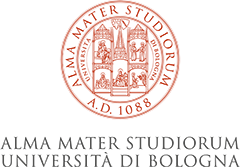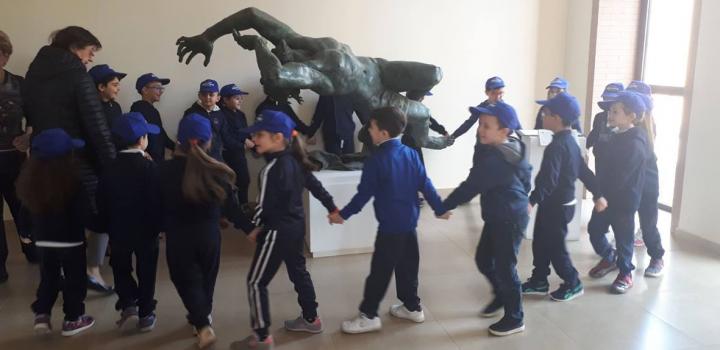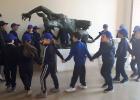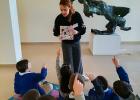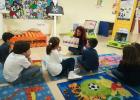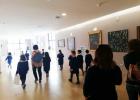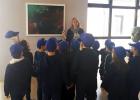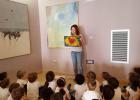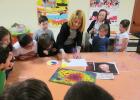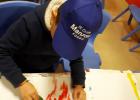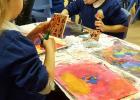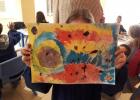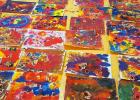Identification Plan
Denominazione dell'istituzione
Pinacoteca "il 9cento", Foggia (Italy)
Indirizzo
Via Marchese de Rosa, Foggia, Italy
Anno di realizzazione
2011- ongoing
Referente/i del progetto
Association of Social Promotion UtopikaMente
A chi è rivolta l'iniziativa
scuola primaria (5-10 anni)
scuola secondaria di primo grado (11-13 anni)
Numero di partecipanti
31
Tipologia/e di intervento/i
visit/tour
didactic activity/atelier
Spazio/i
school
cultural institution (museum, theatre...)
Obiettivi del progetto (max 3)
- Do a first reading/analysis of a work of art
- Get to know the great contemporary artist Joan Mirò
- Identify the multiple functions performed by the image from an informative and emotional point of view
Pedagogical Plan
Intellectual/Cognitive Aspects
Conoscenze di base
- Distinction between abstract and figurative art
- They got to know the main contemporary artists, Mirò
- First exploration of the museum, its contents and purposes
- Experimentation of artistic techniques (sponging and collage)
- Distinction between primary and secondary colors
Rielaborazione
The participants have reworked Mirò's "Constellations" by using the technique of tempera sponge and collage and by using the primary colors and the details of the artist's works in order to produce decorative elements
Socio-relational Aspects
Autonomia
After listening to the operator's instructions for the correct use of the available tools, each participant has produced their own paper autonomously
Collaborazione
In the phase of museum exploration, the participants are stimulated to collaborate in achieving the set goals, such as a "detail-hunt" in the displayed paintings, thanks to the playful dimension of the activity.
At the end of the practical activity, the operator asks the participants to show one another their work and to share the impressions of the experience
Aesthetic/emotional/linguistic Aspects
Polisensoriale
The free access to the objects stimulates the observation in the participants. The displayed shapes, colors and objects stimulate in the young visitors emotions and possible connections with their own experience.
In the laboratory phase, the hands-on methodology is applied. It allows children to manipulate different materials
Espressivo-linguistica/orale
During the visit, the operator asks questions frequently as an input to encourage children to talk and to talk about themselves, in order to create links between the museum experience and their personal experience. They are also encouraged to ask themselves what they have observed and to learn how to describe it. A reflective and sharing process is started
Espressivo-grafico/pittorica
In the workshop phase, participants try and learn artistic techniques such as painting. They learn to use the artist's tools correctly. They give space to their creativity and free self-expression through sign and color. They are inspired by the artist and his works observed. In this way, visitors can process the heritage subjectively by internalizing and re-interpreting the museum experience
Methodological plan
Approccio narrativo
The narrative dimension is privileged in every laboratory of the association; the introduction to the artist / work of reference takes place always through narration, i.e an animated reading of illustrated books and the observation of images, in order to catalyze the attention and encourage the emotional involvement of the participants. Especially with younger visitors, dramatization and reading are crucial to establish an empathic and trusting relationship with the educator
Approccio ludico
Participants are invited to explore the exhibition autonomously in a sort of "painting-hunt", following the operator's instructions about what they should observe; the playful, sensorial and interactive approach catalyzes the attention and the concentration of the children in achieving the final goal. This activates also transversal skills such as the ability to work in groups and the respect for the rules and the others
Osservazione/lettura/produzione
Several works by the artist are shown to the children, in order to explain what abstract art means and show the multiple ways in which this genre can convey emotions and information. In this phase, the contribution of the educator is crucial in stimulating children to ask questions, to observe details, to share reflections and imagine meanings, making a first analysis of a work of art to reach a personal interpretation
Competenze trasversali
creative thinking
Breve descrizione del progetto
The children approach the world of art through the reading of an illustrated book. This is about the adventures of Mirò, surrealist artist and dreamer, who leaves for a fantastic journey to try to tame five impertinent patches of color. In the workshop, each participant create their own surrealist painting inspired by one of Mirò's masterpieces belonging to the series of "Constellations", by using the technique of artistic sponging with tempera colors and collages
Stages of the Project
Initial phase
Descrizione dell'attività
Welcome and introduction to the theme of the workshop
Modalità di coinvolgimento di bambini/e, insegnanti, educatori/educatrici, artisti/e
The operator welcomes the children at the Pinacoteca and verifies their foreknowledge by making stimulating questions (have you ever been in a museum? What is a "picture gallery"? What's inside it? Who works there? What are we going to talk about in this lab?). Then, the children get to know the artist, Joan Mirò, through animated readings (in this specific workshop, the figure of Mirò is introduced by the reading of the book "The most beautiful painting in the world" and "With the eyes of Mirò") and the observation of prints
Intermediate phase
Descrizione dell'attività
Exploration of the exhibition halls and observation of the objects
Modalità di coinvolgimento di bambini/e, insegnanti, educatori/educatrici/artisti/e
Children are invited to explore the exhibition rooms and to look for a painting that recalls the style of Mirò. In this way, the participants are stimulated to observe all the paintings, to reinforce what they have learned about the difference between figurative and abstract art and to appreciate the contemporary artifacts of the local artists located in the Pinacoteca. Everyone is free to explore the spaces autonomously, respecting the rules anticipated by the operator. Once the object has been identified, the final phase that will take place in the laboratory is introduced
Final phase
Descrizione dell'attività
Production of a personal version of the "Constellations" in the laboratory
Modalità di coinvolgimento di bambini/e, insegnanti, educatori/educatrici/artisti/e
The operator shows how to use the primary colors with tempera sponge, in order to create new colors and shades. After that, all the necessary materials are provided (colors, prints of the "Constellations" to be cut, sheets) so that everyone can create their own surrealist "night sky" autonomously
Risultati del progetto (max 3)
- The participants got to know the Pinacoteca, its purposes and the artistic heritage of the territory
- They got to know one of the main contemporary artists (Joan Mirò)
- Experimentation of artistic techniques
Continuità del progetto negli anni
Yes
Tecniche
Drawing, tempera sponge, collage
Materiali utilizzati
Markers, colored pencils, tempera, sponges, picture books, prints
Materiali prodotti
Prototype made with sponge and collage to be shown to the participants as an example of finished work


